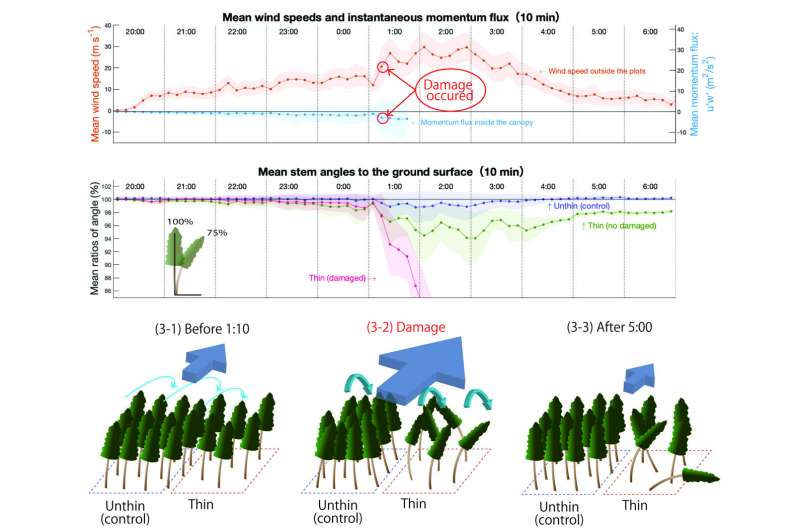How trees reacted to wind during a category-5 tropical cyclone (super typhoon Trami) in 2018. The wind and tree stem angle data describe that tree damage occurred from 1:10 to 1:20 on 1 October 2018 (rapidly changing wind speeds with strong sweep shown as the negative momentum flux u’w’). Before 1:10, all trees were swaying in the similar manner; just after 1:10, the trees in the control plot helped each other by frequently crushing their crowns, whereas the trees in the thinned plot confronted strong wind turbulent individually; when the winds became less strong, the trees in the control plot returned to the rest (original) positions, whereas the undamaged trees without any supports (in the thinned plot) remained at the leaned positions (never back to the rest positions). Credit: Kana Kamimura, Shinshu University
Trees in forests are prone to damage from strong winds. Despite extreme weather events becoming more prevalent, scientists have not yet fully understood why some trees are damaged and other trees survive. A team of researchers led by Dr. Kana Kamimura of Shinshu University succeeded in obtaining unique data when a forest under an ongoing study got hit by the category-5 tropical cyclone Trami in 2018, giving them previously undocumented information about the dynamic responses of trees damaged by wind.
As the climate changes, forest wind damage is expected not only in the current tropical cyclone-affected regions but in much larger regions consisting of trees that have never encountered such extreme conditions. Tropical cyclones are expected to migrate north (in the northern hemisphere) while also increasing in magnitude. To better protect forests—which have important value economically and account for the wellbeing of the ecosystem by providing forest resources, a place for leisure, and carbon sinks—we must better understand how trees and forests survive extreme weather caused by global warming.
Once trees encounter strong wind turbulence exceeding their stability, they fail. Strong winds cause forest damage, but not all trees are uprooted or broken on the stem. To date, the mechanism by which trees fail has been believed to be caused simply by pressure from wind turbulence to the canopy, which leads to tree oscillations; subsequently, the accumulated stress causes stem or root failure. This study is a substantial step in reducing the gap between the current understanding and actual forest damage processes by the wind.
Two plots in Sugi tree (Cryptomeria japonica) planted forests were used for this study: unthinned plots that were the control and thinned plots that have a greater distance between trees. The researchers found that the control plot had no damage while the thinned plot had some damaged trees. The undamaged trees in the thinned plot, however, were leaned, never returning to their original vertical positions. All trees in both plots should have received similar pressure from wind turbulence at the same time; why, then, did some trees survive and not others?
The trees in this study were equipped with sensors monitoring stem strains and crown positions. The researchers were able to collect data from both trees that survived and trees that failed. Similarities and differences of the tree oscillations within and between the different plots were analyzed.
Observing the crown sway data of all trees together, Dr. Kamimura realized that the trees in the control plot helped each other to release strong pressure by frequently crushing their crowns, whereas the trees in the thinned plots had to individually resist the pressure without any help from the neighboring trees, due to the distance between the trees. In other words, the control plot built resilience together and the trees in the thinned plot had to resist strong pressures alone. This answers the frequently discussed question of why trees in forests immediately after thinning are more vulnerable to strong winds. The thinning makes the distance between trees greater, which transforms forests into a collection of single trees by reducing the chance of crown collisions that act as a buffer of energy transfer to the roots.
How the trees are spaced changes the likelihood of tree survival because of the different levels of support provided by neighboring trees. Tree spacing can be controlled through forest management; thus, forest damage risk can be reduced even under climate change conditions.
Further research of diverse forest settings would bring more clues as to how forests have survived millennia and what people can do for forests under changing climates.
"Tree dynamic response and survival in a category-5 tropical cyclone: The case of super typhoon Trami" is published in Science Advances.
More information: Kana Kamimura, Tree dynamic response and survival in a category-5 tropical cyclone: The case of super typhoon Trami, Science Advances (2022). DOI: 10.1126/sciadv.abm7891. www.science.org/doi/10.1126/sciadv.abm7891
Journal information: Science Advances
Provided by Shinshu University
























